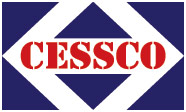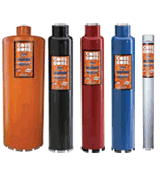Core drilling made simple
There are a lot of factors that
affect core drilling.
Knowing what these factors are can allow you take action
to minimize your cost while maximizing your efficiency. At CESSCO, we want to make sure you find the perfect core drill motors, rigs, and diamond core bits for your specific needs.
Knowing what these factors are can allow you take action
to minimize your cost while maximizing your efficiency. At CESSCO, we want to make sure you find the perfect core drill motors, rigs, and diamond core bits for your specific needs.
Core drilling is mostly about power & speed
The smaller the hole, the faster the required RPMs.
As the diameter of the hole increases, the need for more horsepower also increases. If you're looking to purchase a new motor or rig to core drill, the most important question is what diameter hole(s) are required.
Match the motor to the Core Bit.
Use the Bit Size to find the motor
Use the Bit Size to find the motor
How to Get Started Core Drilling
- Determine the size of hole(s) required.
- Use the above chart "Core Drill Diameter RPMs & HorsePower" and write down the "Min RPM" "Best RPM" and "Max RPM" for each size hole you anticipate drilling.
- These RPM numbers represent the capabilities needed for the core drill motor you will need to use.
- You may see RPM's represented as "Loaded" or as "No-Load" RPMs. Generally "Loaded RPMs represent approximately 60% of the "No-Load" number. The RPM numbers required for each hole need to be "Loaded RPMs" as drilling requires "loading" the motor with force in order to actually drill the hole.
- Are any of the holes you will be drilling larger than 3" in diameter?
3-inch diameter holes and smaller may be drilled using a Hand-Held Core Drill Motor. Larger holes require a Core Drill Rig setup in order to ensure drilling accuracy. Attempting to drill holes larger than 3" in diameter with a hand-held motor increases the odds that the drilled hole will be "off-center" and inaccurate. In other words you will have a very difficult time fitting a 4" pipe into a 4" hole drilled without a core drill rig. When precision drilling is required, always use a core drill rig. - With the above in mind, select the best core drill motor, or core drill rig assembly with motor for your budget and job needs.
- Finding the best core drill bit for the job.
- All wet cutting core bits require water for cooling and performance.
- Know what you're cutting. Select a core bit most suited to the material being cut. When you click on the core bit size you're looking for you'll see the core bits shown by what they're cutting. General Purpose Bits, Hard Material / Reinforced Material, and Soft Abraisive Materials (Asphalt).
- Core Bits can also be special ordered. Special orders can modify production bonds to either harden the bond for more resistence to soft abrasive materials prolonging a bit's life, or softening the bond to more aggressively attack harder materials accelerating cutting speed.
How Diamond Core Bits Work
 Diamond blades don't cut they grind! The exposed diamond
crystals do the grinding work. The metal matrix or bond holds
the diamonds in place. Trailing behind each exposed diamond is
a "bond tail" which helps to support the diamond. As the blade
rotates through the material the exposed surface diamonds grind.
Diamond blades don't cut they grind! The exposed diamond
crystals do the grinding work. The metal matrix or bond holds
the diamonds in place. Trailing behind each exposed diamond is
a "bond tail" which helps to support the diamond. As the blade
rotates through the material the exposed surface diamonds grind.After several thousand passes through the material being cut the exposed diamonds begin to crack and fracture. The matrix holding the diamond also begins to wear away.
Eventually the diamond completely breaks up and it's fragments are swept away with the material that it is grinding.
As the old diamonds are worn down they are replaced by new ones and the process continues until the blade is worn out.
Factors that greatly effect core drilling
Speed |
(RPM) - If the speed is too high the core bit will polish. If the speed is too low the job will take too long. You will know if the bit is "Polished" or "Glazed" when it stops cutting, you have segments left, and you don't see exposed diamonds. To open up the diamonds try drilling in soft abrasive material like a cinder block. Be careful to not drill very much as you will be wasting diamonds. |
Power |
Necessary to maintain the proper cutting speed. Efficient cutting means keeping the bit at the right speed. |
Water |
Not too little and not too much. The right amount removes slurry and keeps the cut clean. Slurry water should look like "Coffee with cream" |
Aggregate |
You can't see it until you're done, but a good driller can feel the right speed and pressure to cut varying types of aggregate. |
Steel |
Slows down the cutting process. Maintaining proper drill motor speed is important. Don't push the bit too hard. Maintain even speed with even pressure. |
Bond Specs |
Too hard and it takes too long. Too soft and it costs too much money. Remember Hard bond for cutting soft abrasive materials, soft bond for cutting hard materials. "Hard on hard" won't cut, and "soft on soft" won't last. |
Proper Alignment |
Necessary for good bit life. This means the core drill rig must be properly anchored. A rig can be anchored with concrete anchors, vacuum or a post jack. Standing on the rig is DANGEROUS and not acceptable |
Core Rig Maintenance |
Performance, speed and bit life will mean little if your rig has bad shims, bearing and hold down devices. |
Troubleshooting
Glazed / Polished Bits - Causes & Remedies
- Possible Cause: Too much feed pressure
Remedy: Open the bit with an abrasive material (Such as sand pot, concrete block, cinder block, etc.). - Possible Cause: Aggregate is too hard. (Example using a bit designed for soft abrasive material to drill concrete).
Remedy: Use a core drill bit designed with a softer bond. - Possible Cause: RPM of core drill is too high for the bit diameter. Surface speed of the bit rotation is a function of RPM and diameter. A fast rotation speed is necessary for small bits, but as bits get larger, circumfrence speed increases relative to p. Too high an RPM and the bit will glaze.
Remedy: Adjust motor speed (if possible), otherwise you will need to purchase a motor with an appropriate speed.
- Possible Cause: Too much feed pressure & not enough water.
Remedy: Repair the bit (if possible). Ease up on the feed pressure and increase water flow. - Possible Cause: Aggregate is too hard. (Example: using a bit designed for soft abrasive material to drill concrete).
Remedy: Use a core drill bit designed with a softer bond.
- Possible Cause: Steel reinforcing rod.
Remedy: Ease up on the feed pressure. Use a higher quality bit and increase the water flow. - Possible Cause: Not enough water to properly cool bit.
Remedy: Increase water flow. - Possible Cause: Drill rig is not properly anchored.
Remedy: There are three ways of anchoring a core rig. STANDING ON IT IS NOT ONE OF THEM! This quick and dirty method damages the bit and the rig as well as dramatically slowing the drilling process.
- Possible Cause: Not enough water to remove slurry.
Remedy: Remove bit and drive core out with a spike through the hub. Increase water flow. - Possible Cause: Core barrel is dented because of hammering on it to remove previous hung up cores.
Remedy: Repair the barrel (if possible). Increase water flow.
- STEP 1: Disconnect the core rig from the bit.
- STEP 2: Thread a piece of threaded rod the same diameter as the bit (bit sizes 1.5" and smaller use 5/8-11 thread and larger bits use 1-1/4-7 thread). Thread through the hub until it hits concrete.
- STEP 3: Place two hex nuts on the rod and lock them against one another so that they in turn lock themselves on the rod.
- STEP 4: Turn the nuts with a wrench which will turn the rod which will push against the concrete core, pulling the bit from the hole without damaging it.

 Pro Cutter Guide
Pro Cutter Guide  Diamond Products
Diamond Products  Core Bit RPMs & Hp
Core Bit RPMs & Hp

